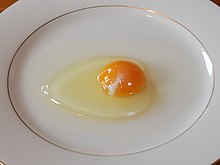
Back Clara de uevo AN بياض البيض Arabic Oagloa BAR Puti kan sugok BCL Яйчен белтък Bulgarian ডিমের শ্বেতাংশ Bengali/Bangla སྒོང་སྤྲི། Tibetan Clara d'ou Catalan Bílek Czech Eiklar German

Egg white is the clear liquid (also called the albumen or the glair/glaire) contained within an egg. In chickens, it is formed from the layers of secretions of the anterior section of the hen's oviduct during the passage of the egg.[1] It forms around fertilized or unfertilized egg yolks. The primary natural purpose of egg white is to protect the yolk and provide additional nutrition for the growth of the embryo (when fertilized). Egg white consists primarily of about 90% water into which about 10% proteins (including albumins, mucoproteins, and globulins) are dissolved. Unlike the yolk, which is high in lipids (fats), egg white contains almost no fat, and carbohydrate content is less than 1%. Egg whites contain about 56% of the protein in the egg. Egg white has many uses in food (e.g. meringue, mousse) as well as many other uses (e.g. in the preparation of vaccines such as those for influenza[2]).
- ^ Ornithology, Volume 1994 By Frank B. Gill p. 361
- ^ James, John M.; Zeiger, Robert S.; Lester, Mitchell R.; Fasano, Mary Beth; Gern, James E.; Mansfield, Lyndon E.; Schwartz, Howard J.; Sampson, Hugh A.; Windom, Hugh H.; Machtinger, Steven B.; Lensing, Shelly (1998). "Safe administration of influenza vaccine to patients with egg allergy". The Journal of Pediatrics. 133 (5): 624–8. doi:10.1016/S0022-3476(98)70101-5. PMID 9821418.